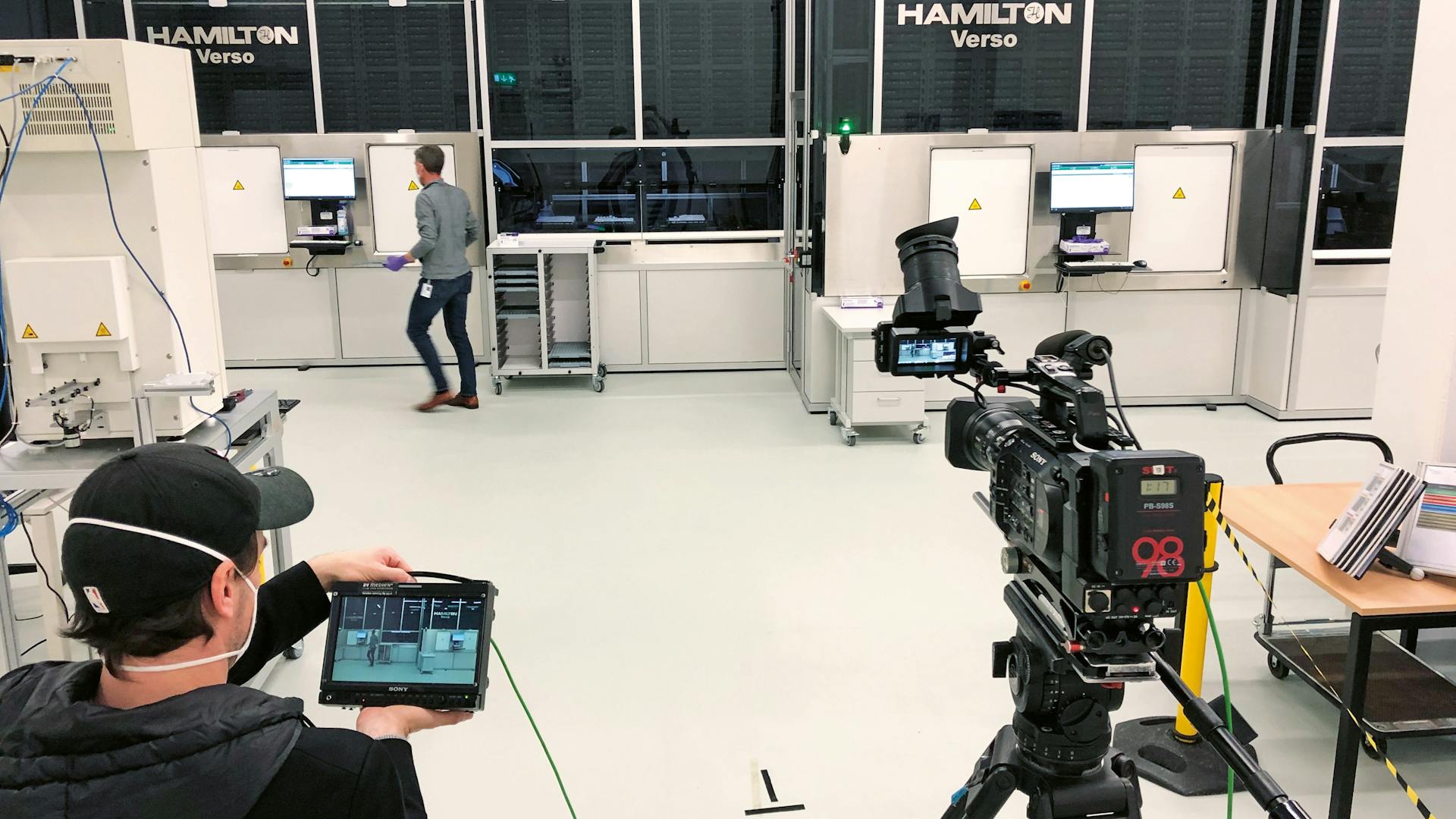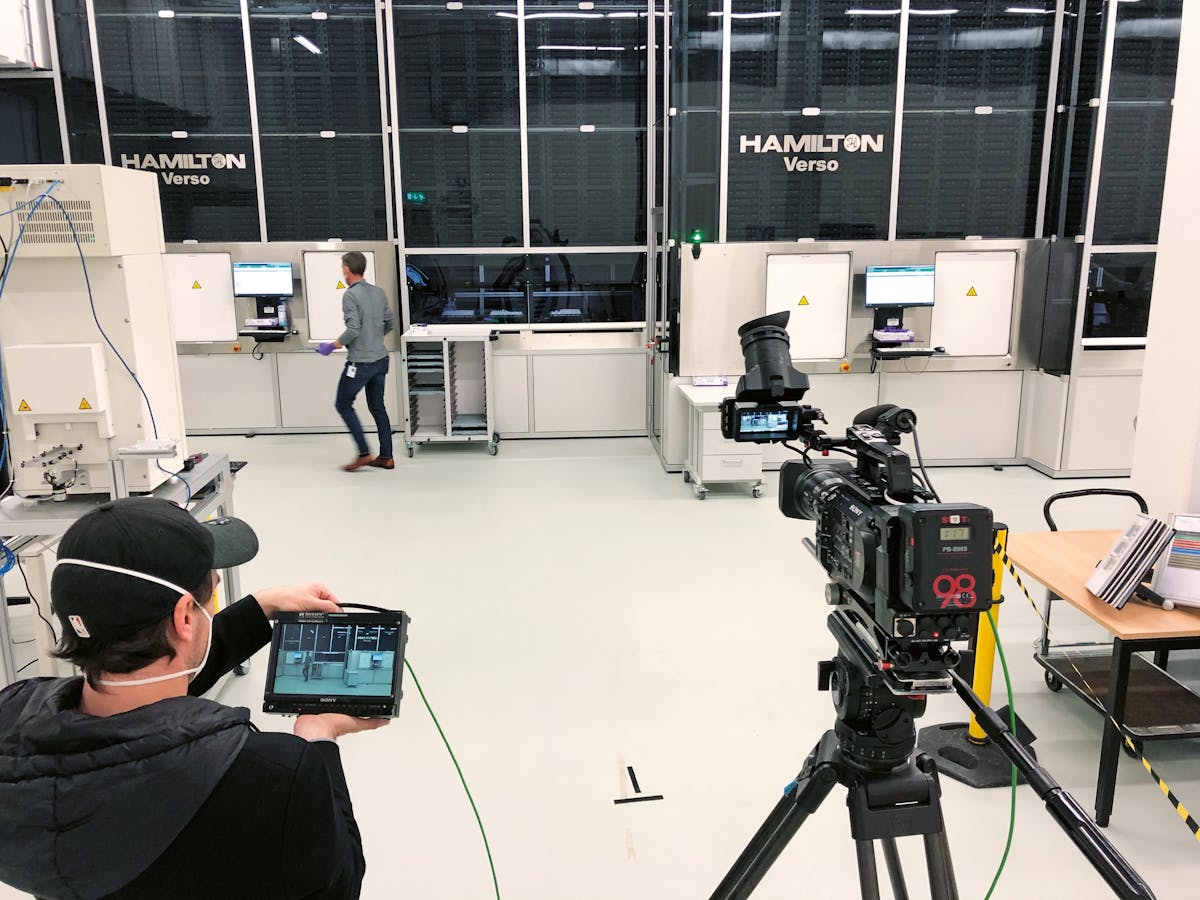
Filming of an explanatory video for the Wonders of Medicine exhibition.
When Novartis launched a competition for the design of a permanent exhibition in 2014 to allow the public to take a deeper look at pharmaceutical research and development, a wind of change was blowing across the industry.
As traditional patterns of communication and interaction were breaking down due to the rise of social media, the ubiquitous call for greater openness and transparency was posing unique challenges for companies, prompting them to take new measures to keep abreast of the latest social developments.
At Novartis, too, corporate culture was moving to the forefront. At the same time, the company was also exploring new ways to tear down communication barriers, address people’s concerns and foster closer dialogue with the public. It was against this background that the story of the Pavillon exhibition unfolded, spanning some eight years that were fraught with plenty of stumbling blocks.
Beginnings
The competition, in which a number of internationally renowned design and architecture firms took part, saw Atelier Brueckner emerge as the winner. The Stuttgart-based company, which has vast experience in scenography and realizes hand-on interactive exhibits throughout the world, was commissioned to provide the appropriate setting for the vision of Novartis to engage in an active dialogue with the public.
Elisabeth Ramm, Lead Concept Design at Atelier Brueckner and one of the creative minds behind the exhibition, was well aware of the difficulty of the assignment from the outset: “On the one hand, the peculiarity lay in the sheer complexity of the subject to be represented. On the other hand, we first had to get a good grasp of the project’s scope to do justice to the breadth of topics associated with pharmaceutical research.”
The project envisioned by Novartis was unprecedented. But Atelier Brueckner did not shy away from the challenge. They soon began weighing diverse design options while considering how to break down complex medical contexts in a visually appealing and accessible way.
“During the brainstorming and subsequent concept development, we were inspired by the culture and goals of Novartis,” Elisabeth Ramm said, describing the project’s beginnings. “From this, the leitmotif emerged naturally: time. On the one hand, we were eager to demonstrate that the pharmaceutical innovations of recent decades have immensely expanded the spectrum of therapeutic options. On the other hand, we wanted to convey the message that drug development is a lengthy undertaking that takes years, if not decades,” Ramm said.
Indeed, the motif of time is mirrored in both the aesthetics and the structure of the exhibition. For instance, relying on interactive installations and visuals, the section From Laboratory to Patient portrays the process of drug development, exploring the long and arduous journey from the research lab to the patient.
The genesis of the Pavillon
As soon as the conceptual groundwork and fundamental design principles were established, the question arose where to locate the exhibition. One of the first drafts envisaged converting the upper floors of a high-rise block on the Campus into an exhibition venue. Under this plan, the 12-story building was to be revamped and extended to include a luminous observation tower to meet the high technical and aesthetic demands.
This idea was later discarded in favor of the Pavillon, which would not only accommodate the exhibition and serve as a venue for public discussions, but also come to epitomize the company’s willingness to open up to the outside world. That’s how the creators got down to work to turn the concept, developed jointly by Atelier Brueckner and Novartis, into reality.
Humanistic approach
While Atelier Brueckner crafted the conceptual framework and ensured that subcontractors fulfilled their assigned duties, content creation was the responsibility of David Woodruff, who, as content director, not only drafted the exhibition texts, but also accentuated a lot of creative features.
Woodruff, a journalist by profession, had a long and successful career before he joined the project. His first career stop was in Kalamazoo, a small town in southern Michigan, where he worked as a reporter for a local newspaper. A few years later, he joined the Business Week magazine, where he regularly published articles on automotive and mobility topics. He gained further experience at the Paris bureau of the Wall Street Journal, at the OECD, and business magazine McKinsey Quarterly, among others. He joined Novartis in 2013 to offer his many years of storytelling expertise and help the company develop further in this field.
When Woodruff was asked to support the Pavillon exhibition and take charge of developing the thematic content in the spring of 2020, he was initially startled, having never worked on an exhibition before, let alone implemented one. “The task was to visualize and explain an extremely complex field, which is only accessible to a limited circle of researchers, in such a way that it could be understood without great effort even by non-professionals. This is where my experience as a journalist came in handy, as it is my job to translate difficult issues into clear language that anyone can understand, and to convey them in a clear and accessible manner,” Woodruff said.
Step by step, Woodruff and his team succeeded in molding the story of pharmaceutical research – a field marked by constant transformation and disruptive changes of unprecedented magnitude – into a narrative and shaping scattered fragments into a larger, coherent story.
At the same time, the creators were also intent on integrating patient experiences into the exhibition to paint a holistic picture of how the company operates. “Our priority was to put people at the center,” said Woodruff, describing the underlying structure of the project. “We went to great lengths to shed light on patients’ experiences and render their stories faithfully and emphatically, albeit without succumbing to pathos of any kind.”
In three interactive booths, each featuring a real patient and their family members, visitors can learn firsthand, for example, about different medical conditions, as well as their respective treatment options. A further section of the exhibition features a set of virtual windows. Each of the eight windows displays a particular drug development stage – be it a production facility or a laboratory – including Novartis associates who work at these locations, reflecting the people-focused approach.
Defying the pandemic
Getting such a comprehensive exhibition off the ground during a global pandemic was anything but easy. Not only did the conversations with scientists, which were essential to capture complex pharmaceutical content, have to be conducted virtually, the filming also took place under highly unfavorable conditions. When borders around the world started to close at the onset of the pandemic, the planned shoots abroad needed to be canceled, threatening to upset the tight schedule.
As a result, local camera crews were hired to shoot in the United States, the United Kingdom, Kenya and other locations with a number of selected protagonists. During the process, Woodruff’s team was present at all times via video link and steered the work remotely. However, this didn’t always go off without a hitch. “Today’s technology allows us to monitor and accompany remote shoots virtually via video feed. Nevertheless, there are always challenges that need to be overcome,” said Samuel Ackermann, creative producer at AV-Medien, who accompanied the filming from day one.
“Due to the large distances, different time zones and, in some cases, limited technical conditions, there can be problems with the transmission. Picture and sound recorded on location is usually transmitted to headquarters with a time delay, which makes real-time communication much more difficult. It’s very different from being live on set and being able to talk directly to everyone involved,” Ackermann explained.
However, none of this prevented the creative minds from bringing the exhibition to completion: “The pandemic weighed heavily on us, forcing us to think out of the box and come up with innovative solutions. Against all odds, however, we managed to create an exhibition that is consistent not only visually, but also in terms of content and dramaturgy,” Woodruff said.
When the journey began in 2014, few could have imagined that the project’s realization would take so much time and be such a struggle. Eight years later, the Pavillon stands, elegantly rising into the blue sky to host one of the world’s first holistic industrial exhibitions, representing openness and renewal.





